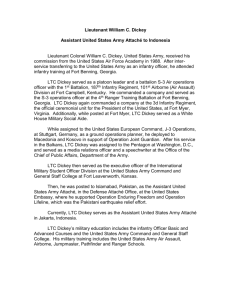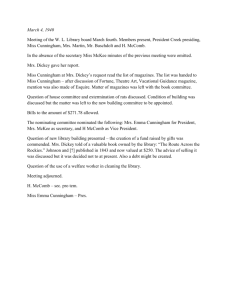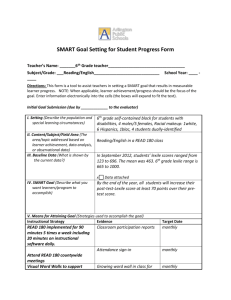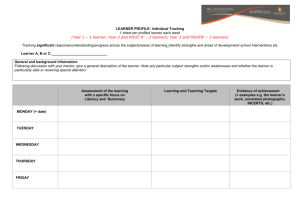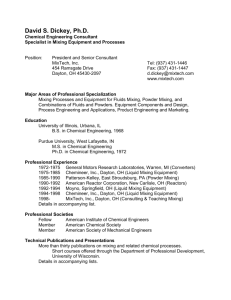holmes_fe02 - Vance Cameron Holmes
advertisement
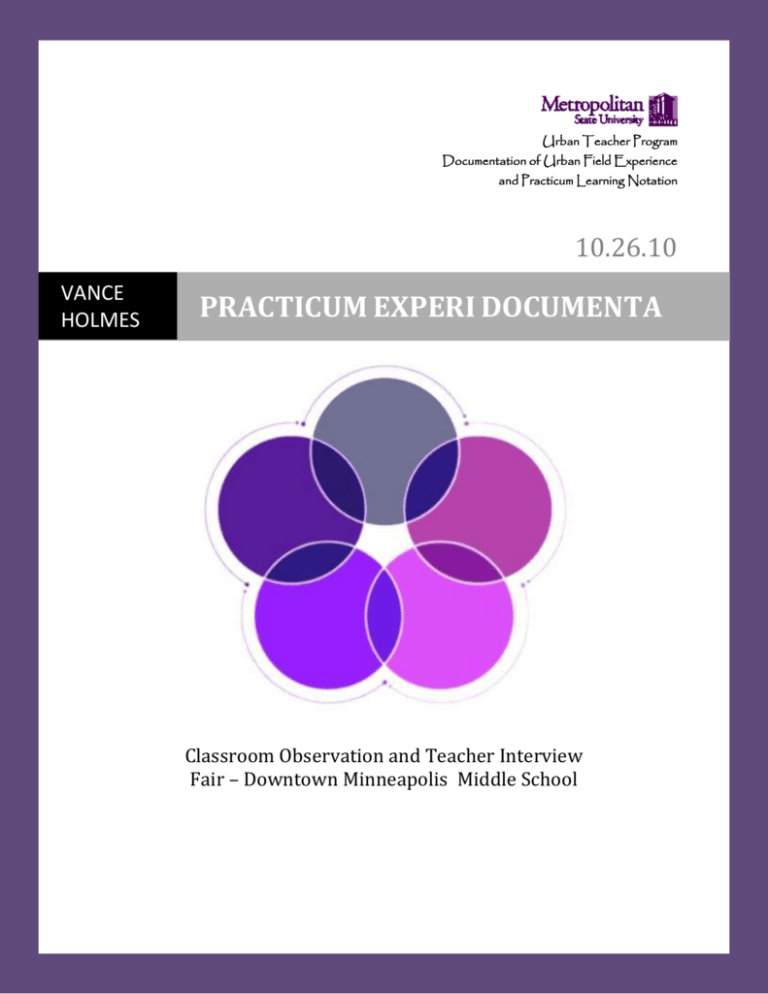
0 Urban Teacher Program Documentation of Urban Field Experience and Practicum Learning Notation 10.26.10 VANCE HOLMES PRACTICUM EXPERI DOCUMENTA Classroom Observation and Teacher Interview Fair – Downtown Minneapolis Middle School 1 DOCUMENTATION OF URBAN FIELD EXPERIENCE ARTIFACT Classroom Observation and Teacher Interview LOCATION Fair School - 10 South 10th St - Minneapolis DIVERSITY Students of Color (56%), Students Qualifying for Free/Reduced Lunch (73%), Identified ELL (16%) DATE | TIME CONTACT October 6 & 7 – 2010 October 25, 2010 Susan D. / Laurie Lamberty GRADE LEVEL Middle School TOTAL HOURS 10:00 – 2:00 PM 3:00 – 5:00 PM 10 Hours PRACTICUM LEARNING NOTATION 2 Observation October 6 & 7, 2010 Parent-Teacher Conferences October 25, 2010 Reflections on Literacy and Strategic Instruction in the Urban Classroom Part I: The Interview The urban learner observed for this assignment, referred to hereafter as JP, is an 11-yearold, African American boy. He is a 6th grader attending FAIR School in downtown Minneapolis. He is clever, energetic – and clearly likes his teacher, Susan Dickey. Just as I was arriving for my initial observation, Ms. Dickey was busily attempting to usher JP and her other students into her classroom area. The absence of walls in the open classroom design at FAIR allows hallway areas to blend into classroom space. The students at this school have a rotating schedule of classes and they move to different classroom spaces throughout the day. I was immediately struck by how different this arrangement is from the traditional 6th grade classroom. As her students were assembling for the period, Susan Dickey introduced herself and welcomed me. Ms. Dickey has been teaching in the public schools for ten years – and has enjoyed every minute of it! She is very happy working and teaching students at FAIR School. Speaking specifically about reading, Ms. Dickey says most of her students love to read. She is never short on volunteers to read in class. The students seem to thoroughly enjoy reading aloud in class as well as reading on their own. Asked about proficiency, Ms. Dickey feels that generally, students are reading at levels appropriate to 6th grade. Over the last few years, she has seen improvement in the preparedness and reading capabilities of students as they enter her 6th grade classes. Part II: The Observation 3 The furniture and other items have been arranged into separate areas. Desks are situated in somewhat of a semi-circle. Ms. Dickey’s desk is in the far corner of the room near the Smart Board. Across from the Smart Board are several computer workstations. Instead of ordinary chairs, the students are seated on large, rubber Stability Balls. There is always a bit of bouncing and rolling going on at the desks. Ms. Dickey clarified that the Stability Ball chairs are effective in relaxing students by providing a stable place to sit while also allowing them a range of movement. The session began with Ms. Dickey placing a worksheet with seven sentences on the Smart Board. The students were asked to silently read and review the statements, looking for errors. Learners were then asked to raise their hands and when called, point out a mistake in the sentences. As they offered corrections to spelling, grammar and punctuation, Ms. Dickey wrote corrections to the sentences on the Smart Board. After each student correction was noted, the instructor would ask if there were any more mistakes identified in the statements. The students were successful at the exercise and in less than ten minutes had completed the worksheet. Ms. Dickey seemed satisfied with the results and moved on to her next scheduled activity: vocabulary definitions. Students were given a list of vocabulary words which also appeared on the Smart Board. The list pertained to the various parts and elements of a story and included words like protagonist, setting, action and climax. Ms. Dickey reviewed the list with her class, speaking each word aloud. Students were then instructed to work with a partner to locate definitions of the terms in a dictionary. Having quickly separated into pairs, the students got their dictionaries and sat in various places around the area. I was able to work with JP during this time. Twenty-five 4 minutes later, students were told to finish what they were doing and return to their desks. After a few announcements, Ms. Dickey sent the students to their next class period. My observation at FAIR School was a pleasantly surprising and productive experience. The open, non-traditional elements of the classroom seemed to add a vibrancy and energy to the proceedings that I have not seen in other schools. I was most impressed with Susan Dickey’s ability to manage the classroom, moving swiftly through activities but always giving clear, concise directions. Ms. Dickey has a very personal and personable manner with her students. They obviously admire, trust and respect her a great deal. This observation has shown me that a positive, caring environment -- where learners feel personally valued -- is critical to maximizing student achievement. Part III: Learner Reading Support JP, the urban learner I worked with, seems to be a bright, well-adjusted child. It was an honor to study with him and help him through his assignment. JP is a competent reader. For the most part, he was able to read and comprehend the words on the assignment worksheet. We worked through his assignment together and it went smoothly. However, one item on the worksheet of words was actually a phrase: “rising action.” Obviously the phrase did not appear in the dictionary. JP was confused. Based on some conversations I was overhearing, other students were also confused by the terminology. I was able to employ a modified version of the Anticipation/Reaction strategy to guide JP’s learning. From discussion about what he thought the phrase “rising action” may mean and relating his prior knowledge to the work, JP was able to complete his assignment. Having attended JP’s class on the subsequent afternoon, I was pleased to see that JP was one of the few students to offer the correct answer when the class was asked to 5 define “rising action.” The teacher acknowledged that the phrase should not have appeared on the list since it could not be found in the dictionary. I take away two important lessons from this experience. First, it’s important to remember that reading strategies are actually thinking strategies! Secondly, to be an effective teacher, I must be certain that the assignments I give my students can successfully be completed with the materials given. Part IV: Response to Questions 1. JP, the urban learner observed for this assignment, is an 11-year-old, African American boy. He is a 6th grader attending FAIR School in downtown Minneapolis. He is clever, and energetic, and says he enjoys reading all sorts of materials, including the newspaper! 2. The reading materials used were JP’s assigned readings from class and a dictionary. 3. I was able to employ two strategies: Anticipation/ Reaction Guide and Think Aloud. The most effective strategy was the Anticipation/ Reaction Guide. 4. The instruction I delivered was certainly hands on, differentiated, collaborative and meaningful. 5. Through my two sessions with JP, I was able to employ constructive principles and work as a partner with the student in the learning process. 6. JP’s teacher, Ms. Dickey, identified what the student was to learn. We worked together on the assignment, but I allowed JP to take ownership of the material. 7. I am an African American. JP is an African American. I do not believe race, ethnicity, or the color of skin played any role in providing support in reading instruction. 8. One item on JP’s word definition assignment did not appear in the dictionary. JP was confused. I was able to employ a modified version of the Anticipation/Reaction strategy to guide JP’s learning. 6 9. Through use of the Anticipation/Reaction strategy, I was able to make the content relevant to JP. When he was able to relate the content to reading the newspaper, the learner found an appreciation for the material. 10. I was not prepared to assign the learner to write a paragraph. It would be highly inappropriate to contact the child. He said he thoroughly enjoyed our sessions. 11. Overall, I feel I did a terrific job in assisting my learner to reach the standards set for literacy. 12. This project was a valuable learning opportunity for me. I have gained more experience to add to my twenty years of working with urban students. I have learned that organization is critical to teaching. Educators take on a very important responsibility to students, families and communities. Therefore teachers must always be organized and prepared. I have also learned that, faced with the many challenges of the multicultural metropolitan classroom, urban educators must be armed with several research-based reading strategies that have been proven effective in raising student achievement. Part V: Response to Findings Through this assignment, I was able to reflect on several factors relating to the effective teaching strategies that have been discussed throughout the course. Principle among them is the concept of activating the learner’s background knowledge. As a new urban educator, this requires me to remember that each learner brings his or her own unique knowledge base into the classroom. Students are best taught when they are able to make connections between what they already know and the new ideas and information they are being taught. The other main concept that was verified by this field research was that urban learners must be actively engaged in understanding words and must have vocabulary learning personalized.
